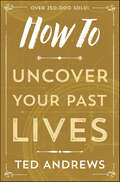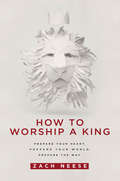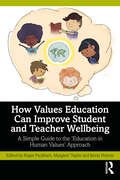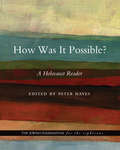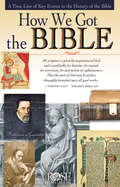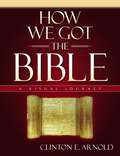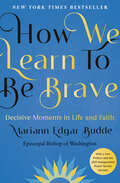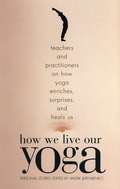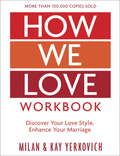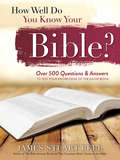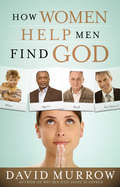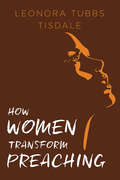- Table View
- List View
How To Uncover Your Past Lives
by Ted AndrewsHave you ever experienced a feeling of déjà vu...or had recurring dreams of a particular place or time...or felt instantly close to some person? All these experiences provide clues to past lives.With How To Uncover Your Past Lives, you'll learn how knowledge of past lives can help you gain clear insight into your spiritual purpose for this lifetime. Popular author Ted Andrews teaches you how to safely and easily explore past-life memories using self-hypnosis, meditation, dowsing, fragrance, and crystals. Discover how to:Use past-life awareness as a tool for spiritual growthRecognize soul mates and their role in your lifeUnderstand the true meaning of a twin soulLet go of self-defeating behaviors and beliefs from past livesGain insight into your life's purpose
How To Understand Your Bible: A Philosopher's Interpretation of Obscure and Puzzling Passages
by Manly Palmer HallIn this classic of comparative religion, Manly Hall marshals his considerable familiarity with world religious traditions to argue that sound biblical interpretation requires cross referencing all the great schools of ancient religion and considering them as one composite structure.
How To Worship a King: Prepare Your Heart. Prepare Your World. Prepare The Way.
by Zach NeeseWorship is more than music. It is the impetus for everything we do as Christians. It is expressed through every action of our lives and helps us become more Christlike. When we learn to worship God through our life, we become better Christians, ministers, musicians, parents, and mechanics.Transform every area of your life through worship.This book unfolds a holistic view of worship so that you can experience peace, joy, and the richness of living in God&’s presence. Be drawn to the heart of God as you explore answers to important questions such as:What are praise and worship, and what is my part in them? If I&’m not a musician or singer, how can I be a worship leader?What does the Bible teach about how we come into the presence of God and how we lead other people into the presence of God?
How Values Education Can Improve Student and Teacher Wellbeing: A Simple Guide to the ‘Education in Human Values’ Approach
by Margaret Taplin Roger Packham Kevin FrancisPresenting Values Education as a solution to major challenges in education such as student disengagement and teacher burnout, this book provides a wealth of practical advice about how to implement the Education in Human Values approach in schools, promoting wellness and improved educational outcomes.Values Education is a world-wide movement and comes in several forms. This book explains the need for and nature of values education, provides practical, easy strategies for implementing the Education in Human Values (EHV) approach, and outlines the educational theories that underpin it. The practical strategies in this book can be implemented in small increments in all aspects of school life. The focus is on both student and teacher wellbeing. The methods can also be used by teachers to address their own professional and personal challenges and to help them cope with difficult situations that cannot be changed.Written for teachers, teacher educators, and teachers in training, this book is the one-stop-shop for gaining a better understanding of values education, how it can support whole-school wellbeing and how to implement it effectively.
How Violence Shapes Religion: Belief and Conflict in the Middle East and Africa
by Ziya MeralIs there an inevitable global violent clash unfolding between the world's largest religions: Islam and Christianity? Do religions cause violent conflicts, or are there other factors at play? How can we make sense of increasing reports of violence between Christian and Muslim ethnic communities across the world? By seeking to answer such questions about the relationship between religion and violence in today's world, Ziya Meral challenges popular theories and offers an alternative explanation, grounded on insights inferred from real cases of ethno-religious violence in Africa and the Middle East. The relationship between religion and violence runs deep and both are intrinsic to the human story. Violence leads to and shapes religion, while religion acts to enable violence as well as providing responses that contain and prevent it. However, with religious violence being one of the most serious challenges facing the modern world, Meral shows that we need to de-globalise our analysis and focus on individual conflicts, instead of attempting to provide single answers to complex questions.
How Was It Possible?: A Holocaust Reader
by Peter HayesAs the Holocaust passes out of living memory, future generations will no longer come face-to-face with Holocaust survivors. But the lessons of that terrible period in history are too important to let slip past. How Was It Possible?, edited and introduced by Peter Hayes, provides teachers and students with a comprehensive resource about the Nazi persecution of Jews. Deliberately resisting the reflexive urge to dismiss the topic as too horrible to be understood intellectually or emotionally, the anthology sets out to provide answers to questions that may otherwise defy comprehension. This anthology is organized around key issues of the Holocaust, from the historical context for antisemitism to the impediments to escaping Nazi Germany, and from the logistics of the death camps and the carrying out of genocide to the subsequent struggles of the displaced survivors in the aftermath. Prepared in cooperation with the Jewish Foundation for the Righteous, this anthology includes contributions from such luminaries as Jean Ancel, Saul Friedlander, Tony Judt, Alan Kraut, Primo Levi, Robert Proctor, Richard Rhodes, Timothy Snyder, and Susan Zuccotti. Taken together, the selections make the ineffable fathomable and demystify the barbarism underlying the tragedy, inviting readers to learn precisely how the Holocaust was, in fact, possible.
How We Believe: Science, Skepticism, and the Search for God
by Michael ShermerA new edition covering the latest scientific research on how the brain makes us believers or skepticsRecent polls report that 96 percent of Americans believe in God, and 73 percent believe that angels regularly visit Earth. Why is this? Why, despite the rise of science, technology, and secular education, are people turning to religion in greater numbers than ever before? Why do people believe in God at all? These provocative questions lie at the heart of How We Believe , an illuminating study of God, faith, and religion. Bestselling author Michael Shermer offers fresh and often startling insights into age-old questions, including how and why humans put their faith in a higher power, even in the face of scientific skepticism. Shermer has updated the book to explore the latest research and theories of psychiatrists, neuroscientists, epidemiologists, and philosophers, as well as the role of faith in our increasingly diverse modern world.Whether believers or nonbelievers, we are all driven by the need to understand the universe and our place in it. How We Believe is a brilliant scientific tour of this ancient and mysterious desire.
How We Got Our Bible
by W Griffith ThomasIs the Bible God's Word? Or does it contain God's Word? How much of it is accurate? Can it be trusted? How can one be sure? Who decided which books were to be included? What about the books which were left out? How have archaeological discoveries affected the Bible? These forthright questions—and scores more—are clearly and concisely answered in How We Got Our Bible.W. Graham Scroggie has said that "the reading of Dr. Thomas' books creates in one a deeper love of and desire for God as revealed in His Word," and this is strikingly ture of this clear and satisfiying marshaling of evidence as to what the Bible is.In twelve fact-packed chapters, Dr. Thomas ably discusses the structure and history, canonicity, authority, trustworthiness, unity, progressiveness, inspiration, interpretation and purpose of the Bible. Questions conclude each chapter, giving How We Got Our Bible a wide range of usefulness.
How We Got the Bible (Third Edition, Revised and Expanded)
by Neil R. LightfootHow and when did the books of the Bible originate? In what sense are these books different from other books? How have these books been preserved and transmitted to us? Why do we have so many different translations of the Bible? How We Got the Bible provides factual, accessible answers to questions like these. A classic guide for Bible students, it has sold more than 300,000 copies during its forty years in print. Now, in this new edition, each chapter has been revised and chapters have been added, including two on the Septuagint and the Latin Vulgate. This thorough revision will tempt fans of the previous edition and pave the way for a new generation of readers as well.
How We Got the Bible: A Time Line Of Key Events In The History Of The Bible (How We Got The Bible Ser.)
by Rose PublishingThe How We Got the Bible ebook will increase the confidence of every believer regarding the reliability of the Bible. The bestselling ebook includes a time line of key events in Bible-making history, examples and illustrations of ancient writing materials, and a variety of Bible versions. This full-color ebook includes the inspiring stories of early translators who gave their lives to translate and print the Bible, including William Tyndale, John Wycliffe, King James, Erasmus, and Johann Gutenberg. Few stories in the history of the world are as amazing and as touching as the story of how we got the Bible. This stunning pamphlet takes readers through this historical story and a time line of faithfulness, courage, and sacrifice for the sake of making the Bible available to us today. How We Got the Bible provides: •Ten key points on how we got the Bible •Illustrations of ancient documents created on papyrus and fine animal skins, as well as the first printing press •A time line that follows the emergence of the Scriptures that begins in 2000 BC and each major step taken in Bible publishing through AD 2000 How We Got the Bible is an amazing ebook that will encourage every believer, and that answer the questions of those still seeking. The ebook reveals how the Old and New Testaments were communicated through a variety of forms beginning as early as 1500 BC when they were written on stone, clay and leather, and later on papyrus, and fine animal skins. Discover the reasons we can trust the reliability of the Bible, for example, how earliest Bible manuscripts were intricately copied by hand and how ancient texts, such as the Dead Sea Scrolls, validate the earliest manuscripts. A time line in the ebook displays the remarkable and fascinating history of the Bible beginning in 2000 BC with Old Testament writers. The time-line captures key moments in Bible-making history such as: •The translation of the Septuagint, the Hebrew Old Testament translated into Greek in 500 BC •The collection of the 27 Books of the New Testament and formal confirmation of the Canon in AD 300 •The first English translation of the Bible by John Wycliffe in 1300 •The King James Version of the Bible written in 1611 •The discovery of the Dead Sea Scrolls in 1947 •The creation of dozens of modern versions of the Bible through 2008 How We Got the Bible ebook reveals the people that were key to Bible translation history, including: Erasmus, Martin Luther, William Tyndale, Miles Coverdale, and many others.Topical index: Apocrypha, Augustine, Bible translations, church fathers, codex, Dead Sea Scrolls, earliest translation, earliest translations, first book printed, first English Bible, Gutenberg, Hebrew Scriptures, Jewish tradition, Martin Luther, manuscripts, Maoretic text, New Testament, Old Testament, Origen, papyrus, parchment, Qumran, Roman type, scribes, scroll, scroll of Isaiah, scrolls, Tyndale, Vatican Library, vellum, Whittingham, Wycliffe
How We Got the Bible: A Visual Journey (Zondervan Visual Reference Series)
by Clinton E. ArnoldHow did the Bible come to be? How has it been passed down to us through the ages? Is it still trustworthy and relevant after all these years? The Bible is the bestselling book of all time and the basis of faith for billions of people around the world. Encompassing the fields of archaeology, biblical studies, and history, the story of how the Bible has come to us today is a fascinating one. It is told here, accompanied by beautiful full-color photographs and illustrations. You’ll marvel at the care and reverence with which this ancient book has been preserved. Just a few of the remarkable insights you’ll gain include scriptural origins on animal skins and clay tablets and the discovery of the Dead Sea Scrolls.
How We Heal: Uncover Your Power and Set Yourself Free
by Alexandra ElleBeloved wellness author and teacher Alexandra Elle shares this practical and empowering guide to self-healing. In How We Heal, bestselling author Alexandra Elle offers a life-changing invitation to heal yourself and reclaim your peace. In these pages, readers will discover essential techniques for self-healing, including journaling rituals to cultivate innate strength, accessible tools for processing difficult emotions, and restorative meditations to ease the mind. Alex Elle elegantly weaves together themes like self-healing, mindfulness, inner child work, and boundary setting and presents the reader with easy-to-follow practices that have changed her life and the lives of the thousands of people she has taught. Her 4-part framework for healing will appeal to anyone who wants a clear process, while the compelling personal stories leave the reader feeling connected and ready to begin again. Complementing the practices are powerful insights from Alex Elle's own journey of self-discovery using writing to heal, plus remarkable stories of healing from a range of luminary voices, including Nedra Tawwab, Morgan Harper Nichols, Dr. Thema Bryant, Barb Schmidt, and many more. Brimming with encouragement and delivered with Alex Elle's signature warmth and candor, How We Heal is a must-have companion for anyone that wants to unlock their inner wisdom and confidence to heal on their own.
How We Learn to Be Brave: Decisive Moments in Life and Faith
by Mariann Edgar BuddeA NEW YORK TIMES BESTSELLERHow We Learn to Be Brave is an inspirational guide to the key junctures in life that, if navigated with faith and discernment, pave the way for us to become our most courageous selves, by the bishop of the famed Episcopal Diocese of Washington, D.C.—now includes a new Preface and the 2025 Inauguration prayer service sermon.On January 21, 2025, many Americans were introduced to Bishop Mariann Budde thanks to what The New York Times called &“an extraordinary act of public resistance.&” During her prayer service for Donald J. Trump&’s second inauguration, Bishop Budde addressed the president directly, imploring him &“to have mercy on the people in our country who are scared now,&” from those who are part of the LGBTQ+ community to immigrants and refugees.But for Bishop Budde, this moment was the culmination of a lifetime spent thinking about those pivot points when we&’re called on to push past our fears and act with strength. With How We Learn to Be Brave, she teaches us that being brave is not a singular occurrence; it&’s a journey that we can choose to undertake every day.Here, Bishop Budde explores the full range of decisive moments, from the most visible and dramatic (the decision to go), to the internal and personal (the decision to stay), to brave choices made with an eye toward the future (the decision to start), those born of suffering (the decision to accept that which we did not choose), and those that come unexpectedly (the decision to step up to the plate). Drawing on examples ranging from Harry Potter to the Gospel According to Luke, she seamlessly weaves together personal experiences with stories from scripture, history, and pop culture to underscore both the universality of these moments and the particular call each one of us must heed when they arrive.With Bishop Budde&’s wisdom, readers will learn to live and to respond according to their true beliefs and in ways that align with their best selves. How We Learn to Be Brave will provide much-needed fortitude and insight to anyone searching for answers in uncertain times.
How We Live Is How We Die
by Pema ChödrönDiscover newfound freedom in life&’s ever-constant flow of endings and beginnings with the wise words of Pema Chödrön, beloved Buddhist nun and bestselling author of When Things Fall ApartAs much as we might try to resist, endings happen in every moment—the end of a breath, the end of a day, the end of a relationship, and ultimately the end of life. And accompanying each ending is a beginning, though it may be unclear what the beginning holds. In How We Live Is How We Die, Pema Chödrön shares her wisdom for working with this flow of life—learning to live with ease, joy, and compassion through uncertainty, embracing new beginnings, and ultimately preparing for death with curiosity and openness rather than fear. Poignant for readers of all ages, her teachings on the bardos—a Tibetan term referring to a state of transition, including what happens between this life and the next—reveal their power and relevance at each moment of our lives. She also offers practical methods for transforming life&’s most challenging emotions about change and uncertainty into a path of awakening and love. As she teaches, the more freedom we can find in our hearts and minds as we live this life, the more fearlessly we&’ll be able to confront death and what lies beyond. In all, Pema provides readers with a master course in living life fully and compassionately in the shadow of death and change.
How We Live Our Yoga: Teachers and Practitioners on How Yoga Enriches, Surprises, and Heals Us: Personal Stories
by Valerie JeremijenkoHow We Live Our Yoga collects fourteen frank, moving, and thoughtful personal essays by passionate yoga practitioners on why they began to practice, what it has brought to their lives, how their relationship to yoga changes and evolves, and more. Judith Lasater looks at the unexpected relationship between yoga and parenting. Award-winning poet Stanley Plumly ponders the connection between his Quaker upbringing, his writing, and his yoga practice. The well-known Sanskritist Vyaas Houston tells the story of his first guru and their difficult relationship. And philosopher and conceptual artist Adrian Piper comes out as a yogic celibate.
How We Love Matters: A Call to Practice Relentless Racial Reconciliation
by Albert TateThis powerful book reimagines discipleship by begging us to acknowledge that racism exists in the Church—and offers the hopeful message that we can disciple it out. It is not an accident that racism is alive and well in the American church. Racism has, in fact, been taught within the church for so long most of us don&’t even recognize it anymore. Pastor Albert Tate guides all of us in acknowledging the racism that keeps us from loving each other the way God intends and encourages siblings in Christ to sit together in racial discomfort, examining the role we may play in someone&’s else&’s struggle. How We Love Matters is a series of nine moving letters that educate, enlighten, and reimagine discipleship in a way that flips the church on its head. In these letters that include Dear Whiteness, Dear America, and Dear Church, Tate calls out racism in the world, the church, within himself and us. These letters present an anti-racist mission and vision for believers to follow that helps us to speak up at the family table and call out this evil so it will not persist in future generations. Tate believes that the only way to make change is by telling the truth about where we are—relationally, internally, and spiritually. How We Love Matters is an exposition of relevant Biblical truth, a clarion call for all believers to examine how they see and understand each other, and it is a way forward toward justice, reconciliation, and healing. Because, yes, it is important that we love each other, but it is even more important how we love each other.
How We Love Our Kids: The Five Love Styles of Parenting
by Kay Yerkovich Milan YerkovichOne small change in how you love; one big change in your kidsHaving problems with your kids? What if you are the problem and you just can&’t see it? How We Love Our Kids offers a unique approach, to help you as a parent transform your kids by making specific changes in how you love. It&’s the only book specifically for parents that reveals the unseen forces that shape every interaction with your kids. • Identify which of the five love styles you have. • Discover the surprising dynamics that shape your parenting. • Get rid of your &“buttons&” so your kids can&’t push them. • Create a close connection with your kids that will last a lifetime. • Learn the seven gifts every child needs. Based on years of research in the area of attachment and bonding, How We Love Our Kids shows parents how to overcome the predictable challenges that arise out of the five love styles and helps parents cultivate a secure, deep connection with a child of any age. Retool your reactions and refocus on how you love. Start today. Watch your kids flourish and thrive as they receive what was missing in your love. With four self-assessments and powerful application tools to use with children of all ages.
How We Love Workbook, Expanded Edition: Making Deeper Connections in Marriage
by Kay Yerkovich Milan YerkovichWhat Determines How You Love?Each of us relates to our spouse based on how we experienced love as a child. In this expanded and enhanced companion workbook to How We Love, relationship experts Milan and Kay Yerkovich offer assessments and conversation starters to help you and your spouse identify your relational patterns and realize how they are affecting you now. Their solution-focused tools help you:* understand why your spouse relates to you the way he or she does* learn how to break free from the barriers that make you feel stuck * see the connection between your personal love style and your childhood * follow specific, clear goals to create a thriving marriage * ask and answer questions strategically with your spouseThe Yerkoviches have helped thousands of couples around the world heal and renew their relationships. This eminently practical guide will take your marriage to the new level of intimacy you’ve always wanted.
How We Love: A Revolutionary Approach to Deeper Connections in Marriage
by Kay Yerkovich Milan YerkovichAre you tired of arguing with your spouse over the same old issues? Do you dream of a marriage with less conflict and more intimacy? Are you struggling under a load of resentment?The key to creating a deeper bond in your marriage may lie buried in your childhood.Your early life experiences create an "intimacy imprint"-an underlying blueprint that shapes your behavior, beliefs, and expectations of all future relationships, especially your marriage. In How We Love, relationship experts Milan and Kay Yerkovich help you pinpoint the reason your marriage is struggling-and they reveal exactly what you can do about it.Drawing on the powerful tool of attachment theory, the Yerkoviches identify four types of injured imprints that combine in marriage to trap couples in a repetitive dance of pain. As you discover how your relationship has been guided by these imprints, you'll gain the insights you need to stop stepping on each other's toes and instead allow yourselves to be swept along by the music of a richer, deeper relationship.From the Hardcover edition.
How We Read the Bible: A Guide to Scripture's Style and Meaning
by Elizabeth R. Hayes Karolien VermeulenThe Bible is interpreted in a variety of ways and through a myriad of lenses. But how we interpret Scripture depends first of all on how we read it. This handbook focuses on the process of reading itself, taking a cognitive-stylistic approach grounded in recent research on language and the mind. Through accessible explanations of twelve key stylistic elements, How We Read the Bible provides all who study Scripture with the tools to understand what happens when we read and draw meaning from biblical texts. Rather than problematizing the divide between authors from the ancient world and a modern-day audience, Karolien Vermeulen and Elizabeth Hayes bridge the gap by exploring the interaction between the cues of the text and the context of the reader. With numerous examples from the Old and New Testaments and helpful suggestions for further study, How We Read the Bible can be used within any framework of biblical study—historical, theological, literary, and others—as a pathway to meeting Scripture on its own terms.
How We Relate: Understanding God, Yourself, and Others through the Enneagram
by Jesse EubanksAn Enneagram book like no other, How We Relate helps you discover how God speaks into your unique personality and life story to make the gospel come alive for you. In How We Relate, Enneagram coach and host of The EnneaCast podcast Jesse Eubanks invites you to discover who you are. In this illustrated guide, he expertly utilizes the Enneagram to lead you to the heart of Jesus, where you will find the wholeness you long for. As you peel back the layers of your False Self, encounter Jesus, and experience the redemption of your True Self, you will discover how to:Understand your personality and the personalities of othersExplore your distinct approach to relationshipsDiscover how Jesus empathizes with and heals your unique core woundInterpret the Enneagram through the gospel storyExperience more meaningful relationships with God, others, and yourself Life is about relationships. It's time to transform yours.
How Well Do You Know Your Bible?
by James Stuart BellAs the bestselling book in the world, the Bible is a source of faith and enlightenment for millions of people. In How Well Do You Know Your Bible?, expert James Stuart Bell presents a dynamic collection of over five hundred questions and answers designed to help readers increase their understanding of the essential Bible events and lessons and have fun at the same time! Blending valuable historical context and quizzes on all sixty-six books of the Bible and both Testaments, this offers a wide variety of questions for readers test their knowledge on various topics including:*The Ten Commandments *The Book of Job *Great women of the Bible *Biblical miracles *And much more! How Well Do You Know Your Bible? is a must-read for Bible enthusiasts, study groups, and anyone interested in learning more about the most revered book of all time.
How Well Do You Know Your Bible?: Over 500 Questions and Answers to Test Your Knowledge of the Good Book
by James BellA must-read collection for Bible enthusiasts, study groups, and anyone interested in learning more about the most revered book of all time. As the bestselling book in the world, the Bible is a source of faith and enlightenment for millions of people. But how well do you really know its stories?Do You Know: What significant event in Jesus's life happened by the brook Kidron? Though he doesn't identify himself in the book, who is generally considered the author of Mark? What was Paul's side story? What does the name Habakkuk mean? Why did God remove Saul as king and replace him with David?Bible expert James Stuart Bell presents an extensive collection of over five hundred questions and answers designed to help readers deepen their understanding and appreciation of the essential Bible events and lessons. Blending valuable historical context and quizzes from all sixty-six books of the Bible, How Well Do You Know Your Bible? offers a variety of questions for readers to test their knowledge and possibly learn something new along the way.
How Women Help Men Find God
by David MurrowHelp for women to understand men's spiritual needs, why today's church doesn't meet them, and how to successfully point them to God.Women don't understand men's spiritual needs but they want to and desperately need to know what they can do (and should not do) to keep their men engaged at church. In the follow-up to his bestselling Why Men Hate Going to Church, author David Murrow speaks directly to women to help them understand the real reasons men resist Christianity. He offers a way of talking about faith that intrigues men instead of repels them and then challenges them to bring more risk and adventure to their own walk with the Lord.
How Women Transform Preaching
by Leonora Tubbs TisdaleWomen preachers are everywhere. The pulpit, once a bastion of male presence and power, has become, in many denominations, a place where women regularly exercise their gifts, leading congregations and proclaiming God's word each week. The number of women scholars who are publishing and teaching in the field of preaching has also expanded dramatically.Leonora Tubbs Tisdale explores how the presence of women preachers and scholars of preaching has transformed the practice of homiletics this country—from the reclamation of women’s “herstory” in preaching, to the topics addressed in preaching and scholarship, to the way in which Biblical hermeneutics and theologizing are undertaken in preaching, to the imagery, illustrations, shape and embodiment of the sermons themselves. How Women Transform Preaching begins with a fascinating survey, including statistical information and historical analysis. Interviewing 16 women preachers/homileticians, Tisdale shares ‘untold stories’ of women preachers throughout history who are largely unknown but who serve as examples of both the struggle and power of women’s preaching. She then tells the stories of contemporary women preachers. Throughout, Tisdale draws practical lessons for the reader, showing what students, homileticians, and preachers can learn from extraordinary women preachers.
